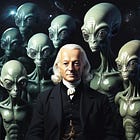Inventing Space Jesus: The Urantia Book And Extraterrestrials In American Religion
An essay in a series on the forgotten origins of UFO belief
During the 18th century, Emanuel Swedenborg published a series of volumes about the progress of the human soul in the afterlife through a universe filled with worlds covered in people. Swedenborg claimed that, by means of spirit-communication and astral travel, he had visited with extraterrestrial beings, living and dead. He described Mercury, Venus, the moon, Mars, Jupiter, Saturn, and extrasolar worlds as well as their humanoid inhabitants.
In this essay series, we have retraced the forgotten story of Swedenborg’s impact on the American religious frontier. From the moment of Independence, sincere belief that humanity existed on other worlds was common. Americans have claimed regular spiritual contact with extraterrestrial beings from the beginning of the nation until the present day. Though we call it the ‘New Age’, this is in fact an Old Time religion, and rather than a foreign import, it is American as apple pie.
Previously in this series:
The Urantia Book is a case in point. Formulated by a disappointed Seventh-day Adventist from the sleeping pronouncements and ‘automatic writings’ of a spirit-medium, the UB is meant to be a whole new revelation for humanity, a gospel from the stars. It was supposed to inspire “a religion the like of which this world has never seen,” according to the son of its creator, who wanted “an international religion … a mankind religion” to replace the strife-ridden spiritual confusion of the present world.1 While there is still a cult of the Urantia Book today, the text has failed to start a mass movement. Rather than a new global religion, the foundation left by the authors of the UB has lost control of the book as well as the believers.
Timing mattered. Conception of what became the UB started before the First World War using the same 19th century methods as a spiritualist medium. Composition of the UB began during the 1930s, when Christian Theosophy cults were at their peak in American life and culture. When the UB was finally published for the world in 1955, those same Christian Theosophists were rebranding, hailing their Ascended Masters from Venus in newly-sighted flying saucers. The UB had missed its moment, becoming a cultural artifact of a forgotten American zeitgeist.
Over 2,000 pages long, UB has seen its most exhaustive study in print by skeptic and debunker Martin Gardner. Urantia: The Great Cult Mystery makes a convincing case that Dr. William Samuel Sadler, an apostate of the Kellogg Sanitarium at Battle Creek, Michigan, used the revelations of a sleeping medium, Wilfred Kellogg, delivered in the style of 19th century Adventist medium and prophetess Ellen G. White. Sadler added copious plagiarism from popular science books, including his own.
Emanuel Swedenborg’s name appears once in Gardner’s book about the UB. when he remarks that it is “crazier than the works of Swedenborg and Davis.” It is reasonable to assume that Gardner did not know much about Swedenborg, had not read his cosmology, and did not understand the plainly-Swedenborgian roots of the spiritual cosmology in the UB. Sadler likely did not know about the long reach of Swedenborg either, for he was too busy updating the modern heaven for his readers to bother working backwards towards primary sources.
By the time the UB was ready for print, the influence of Swedenborg was so intrinsic to the ‘modern heaven’ as conceived in American religion that there was no need to read or reference the ‘Swedish prophet’ at all, anymore. His ideas were everywhere, and belonged to anyone who believed in them, even if most Americans did not even know his name.
Keep reading with a 7-day free trial
Subscribe to Osborne Ink to keep reading this post and get 7 days of free access to the full post archives.







